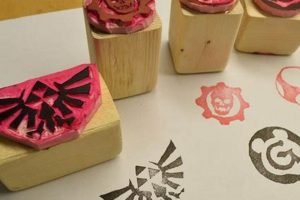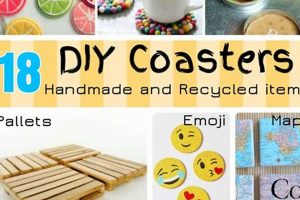Construction of a faux hearth using corrugated fiberboard and a do-it-yourself methodology represents a cost-effective and customizable approach to home decor. This undertaking typically involves acquiring cardboard boxes, cutting tools, adhesive materials, and decorative elements to replicate the appearance of a traditional fireplace. For example, individuals might utilize salvaged cardboard to create a mantelpiece and firebox, subsequently painting or covering the structure to mimic brick, stone, or other desired finishes.
The appeal of this project stems from its affordability, accessibility, and potential for creative expression. It offers a viable alternative for individuals seeking to enhance their living spaces without incurring the expense or permanence associated with installing a genuine fireplace. Historically, similar resourceful building practices have been employed during times of economic constraint or for theatrical set design, highlighting the adaptability of readily available materials to fulfill aesthetic needs.
The subsequent sections will delve into the specific materials required, provide step-by-step construction guidelines, explore various decorative techniques, and address common challenges encountered during the fabrication process. Emphasis will be placed on ensuring structural integrity and achieving a realistic visual outcome, ultimately enabling the creation of a convincing and aesthetically pleasing focal point for interior spaces.
Construction Tips for a Faux Hearth
The following guidelines are intended to enhance the structural integrity and aesthetic realism of a corrugated fiberboard fireplace construct. Adherence to these recommendations will facilitate a successful project outcome.
Tip 1: Material Selection: Prioritize the use of heavy-duty, double-walled corrugated fiberboard. This material offers superior rigidity and load-bearing capacity compared to thinner, single-walled alternatives. For example, appliance boxes or industrial packaging provide a suitable source.
Tip 2: Structural Reinforcement: Implement internal bracing within the firebox and mantelpiece. This can be achieved using additional cardboard strips or wooden dowels affixed with adhesive. Internal supports significantly reduce the risk of collapse under minor stress.
Tip 3: Precise Cutting Techniques: Employ a sharp utility knife with a fresh blade for clean and accurate cuts. A metal ruler or straight edge is essential for maintaining straight lines and preventing jagged edges, which detract from the finished appearance.
Tip 4: Secure Adhesion: Select an appropriate adhesive for bonding cardboard surfaces. Construction adhesive or high-quality packaging tape provides a strong and durable bond. Ensure complete coverage of the joining surfaces to maximize adhesion strength.
Tip 5: Realistic Detailing: Incorporate details that mimic a genuine fireplace. This may include adding a faux brick facade using paint and a sponge, constructing a recessed firebox area, or installing a decorative mantel shelf.
Tip 6: Weight Distribution: Consider the distribution of weight, particularly if items will be placed on the mantelpiece. Reinforce the supporting structure accordingly to prevent sagging or instability. A wider base provides increased stability.
Tip 7: Safety Considerations: Exercise caution when using sharp tools. Work in a well-lit area and utilize appropriate safety equipment, such as cut-resistant gloves. Ensure the completed structure is stable and does not pose a tripping hazard.
These strategies, when implemented effectively, will contribute to the creation of a robust and visually appealing faux fireplace. The result is a decorative element that enhances the ambiance of a room without the costs associated with traditional construction.
The subsequent discourse will address common decorative finishing techniques and potential enhancements that further elevate the realism and aesthetic appeal of the constructed fireplace.
1. Material Acquisition
The process of material acquisition directly impacts the structural integrity and aesthetic potential of a do-it-yourself cardboard fireplace. The selection of appropriate cardboard stock, adhesive agents, and finishing materials serves as the foundational step for the entire project. Substandard materials invariably lead to structural instability and a diminished visual outcome. For instance, utilizing thin, single-ply cardboard from retail packaging will result in a fireplace facade that is prone to buckling and lacking in realistic depth, contrasting with the potential of a heavier appliance box to provide a robust base.
Effective material acquisition involves considering the dimensions of the desired fireplace, the load-bearing requirements for any decorative elements placed upon the mantel, and the intended aesthetic. A larger fireplace necessitates more extensive cardboard sheeting, often sourced from furniture or appliance retailers. The choice of adhesive, whether packaging tape, hot glue, or construction adhesive, must align with the cardboard grade and the intended permanence of the structure. Furthermore, the selection of finishing materials paints, faux brick panels, or decorative trim impacts the realism and overall visual appeal. For example, a realistic brick texture might be achieved through careful application of textured paint and sponge techniques, requiring specialized materials beyond basic household supplies.
Ultimately, a proactive and informed approach to material acquisition is crucial. The time invested in procuring appropriate resources directly translates to a higher-quality, more durable, and visually convincing cardboard fireplace. This initial phase mitigates potential structural failures, enhances the aesthetic realism of the finished product, and maximizes the longevity of the constructed piece, connecting directly to the long-term value and satisfaction derived from the do-it-yourself project.
2. Structural Design
Structural design constitutes a foundational element in the successful execution of any cardboard fireplace project. It dictates the stability, load-bearing capacity, and overall longevity of the faux hearth. A well-conceived structural design mitigates the risk of collapse, warping, or other forms of structural failure, ensuring that the finished product meets both aesthetic and functional requirements.
- Base Construction and Load Distribution
The base serves as the primary support structure for the entire cardboard fireplace. A wider base inherently provides greater stability, preventing tipping or wobbling. The design must account for the anticipated weight load, including the mantelpiece and any decorative items placed upon it. Reinforcement through internal bracing or layering of cardboard may be necessary to distribute weight evenly and pr
event localized stress concentrations. The configuration of the base directly influences the overall stability and safety of the structure. - Firebox Construction and Reinforcement
The firebox, designed to emulate the interior of a traditional fireplace, often requires additional structural support due to its recessed nature. Internal ribs, vertical supports, or strategically placed cardboard folds enhance rigidity and prevent deformation of the firebox walls. The dimensions and shape of the firebox should be carefully considered to ensure structural integrity, particularly if the intention is to incorporate lighting or other decorative elements within the firebox cavity. The inclusion of supports maintains the firebox shape under potential stress.
- Mantelpiece Support and Integration
The mantelpiece, the horizontal shelf above the firebox, requires robust support to bear the weight of decorative objects. The design must effectively integrate the mantelpiece with the underlying structure, distributing the load evenly across the supporting elements. Techniques such as interlocking cardboard flaps, internal gussets, or adhesive bonding can be employed to create a secure and stable connection. Failure to adequately support the mantelpiece results in sagging or detachment, compromising the aesthetic appeal and structural integrity of the entire cardboard fireplace.
- Joint Reinforcement and Adhesive Application
The points where individual cardboard pieces connect represent critical areas of potential weakness. Proper joint reinforcement is essential to prevent separation or structural failure. Overlapping cardboard edges, the strategic application of adhesive, and the incorporation of reinforcing tape contribute to joint strength. The type of adhesive selected influences the long-term durability of the joints; construction adhesive and high-quality packaging tape provide superior bonding compared to standard household glue. Attention to joint detail enhances the overall resilience of the structure.
These structural considerations are interconnected and interdependent. The success of a cardboard fireplace hinges on a holistic approach to design, addressing each element of the structure to ensure stability, safety, and visual appeal. A well-executed structural design transforms simple cardboard into a durable and aesthetically pleasing focal point for interior spaces.
3. Cutting Precision
Cutting precision is fundamentally linked to the successful construction of a corrugated fiberboard fireplace. Imprecise cuts directly compromise the structural integrity and aesthetic realism of the finished product. The inherent nature of corrugated fiberboard necessitates accurate cuts to ensure proper alignment and secure bonding of the constituent components. For example, misaligned edges prevent flush joins, resulting in structural weakness and a visibly amateurish appearance. Conversely, precise cuts facilitate the creation of clean lines, smooth surfaces, and tight-fitting joints, contributing to the illusion of a professionally crafted item. In the context of a do-it-yourself project, this is the difference between a functional fireplace and a stunning piece.
The practical implications of cutting precision extend beyond mere aesthetics. Accurate cuts are essential for achieving the desired dimensions and proportions of the fireplace. A discrepancy of even a fraction of an inch can accumulate across multiple components, leading to a significant deviation from the original design specifications. This is especially critical when constructing complex features such as the mantelpiece or the firebox opening. Furthermore, precise cuts minimize material waste and reduce the need for corrective measures, such as patching or filling gaps, thereby streamlining the construction process and minimizing the risk of structural compromise. For instance, when creating the firebox, uneven cuts prevent the pieces of the firebox frame to square up and have stability.
In summary, cutting precision is an indispensable element in the fabrication of a corrugated fiberboard fireplace. It directly influences structural integrity, aesthetic appeal, and overall project efficiency. While challenges may arise in maintaining consistent accuracy, the benefits of meticulous cutting far outweigh the additional effort required. Ultimately, achieving a high level of cutting precision is crucial for transforming raw cardboard materials into a convincing and durable faux fireplace.
4. Adhesive Selection
The choice of adhesive is paramount in the construction of a corrugated fiberboard fireplace. It directly impacts the structural integrity, durability, and longevity of the finished project. A well-informed decision regarding adhesive selection is, therefore, critical for a successful outcome.
- Load-Bearing Requirements
Different adhesives possess varying load-bearing capacities, directly influencing the stability of the structure. For example, high-strength construction adhesives offer superior bonding for supporting the mantelpiece and any items placed upon it. Conversely, weaker adhesives like standard school glue are inadequate for supporting significant weight, potentially leading to structural failure. Therefore, the adhesive must be selected based on the anticipated load.
- Material Compatibility
Corrugated fiberboard, a porous material, requires adhesives specifically formulated for compatibility. Certain adhesives, such as solvent-based options, may degrade or warp the cardboard, compromising its structural integrity. Water-based adhesives or specialized cardboard adhesives are typically more suitable, as they provide a strong bond without damaging the cardboard fibers. Testing on scrap material is recommended to confirm compatibility before widespread application.
- Drying Time and Application
The drying time of an adhesive influences the pace of construction. Fast-drying adhesives, such as hot melt glue, allow for rapid assembly but may offer limited repositioning time. Slower-drying adhesives, like construction adhesives, provide a longer working window but require clamping or support during the curing process. The application method also varies depending on the adhesive type, impacting the ease of use and precision of bonding. Consideration of drying time and application is therefore, essential.
- Environmental Factors and Durability
Environmental factors, such as temperature and humidity, influence the long-term durability of the adhesive bond. Adhesives exposed to high humidity or extreme temperatures may degrade over time, compromising the structural integrity of the fireplace. Selecting an adhesive with resistance to these environmental factors is crucial for ensuring the longevity of the project. Outdoor exposure, in particular, necessitates a weather-resistant adhesive formulation.
In conclusion, adhesive selection is not merely a procedural step but a critical design consideration. The chosen adhesive must align with the load-bearing requirements, material compatibility, drying time, and environmental factors to ensure a structurally sound and visually appealing cardboard fireplace. Thorough research and informed decision-making are essential for achieving a successful and durable outcome.
5. Surface Finishing
Surface finishing constitutes a critical phase in the creation of a faux hearth utilizing corrugated fiberboard and a do-it-yourself methodology. It transcends mere aesthetic enhancement, significantly impacting the perceived realism and overall visual appeal of the constructed fireplace. The selected finishing techniques and materials determine the extent to which the cardboard structure convincingly replicates the appearance of a traditional fireplace.
- Paint Application and Texture Creation
The application of paint serves as a fundamental aspect of surface finishing. Multiple layers of paint, strategically applied, can simulate the textures and color variations inherent in brick, stone, or wood. Techniques such as dry brushing, sponging, and stippling allow for the creation of realistic surface irregularities. For instance, applying a base coat of dark gray followed by dry brushing with lighter shades of brown and tan can effectively mimic the appearance of aged brick, thus dramatically enhancing the realism of the fireplace construct.
- Faux Material Application (Brick, Stone, Wood)
Beyond paint, the direct application of faux materials further elevates the realism. Thin faux brick panels, adhesive-backed stone veneers, or wood-grain contact paper can be affixed to the cardboard surface, providing a tangible texture and visual depth that paint alone cannot achieve. These materials offer a relatively straightforward method for replicating the look and feel of authentic building materials, thus transforming a simple cardboard structure into a convincing replica of a traditional fireplace.
- Grout Simulation and Detailing
For surfaces intended to emulate brick or stone, the simulation of grout lines is crucial. This can be achieved through various techniques, including the application of caulk, joint compound, or even simply using a dark-colored marker to delineate the individual bricks or stones. Careful attention to grout line width and color contributes significantly to the overall realism of the finished surface, creating a more visually compelling and authentic-looking fireplace facade. These details have a strong contribution to visual effect.
- Protective Coatings and Sealants
The application of protective coatings and sealants extends the lifespan and enhances the durability of the surface finish. A clear coat of polyurethane or varnish protects the painted or faux-finished surface from scratches, scuffs, and moisture damage. This is particularly important for fireplaces that will be frequently handled or exposed to potential spills. Protective coatings not only preserve the aesthetic appeal of the surface finish but also contribute to the long-term maintenance and usability of the cardboard fireplace, which is more safe from environmental impact.
The various surface finishing techniques, from paint application to protective coatings, are intrinsically linked and contribute to the overall success of the do-it-yourself corrugated fiberboard fireplace. The careful selection and application of these techniques transforms a rudimentary cardboard structure into a convincing and aesthetically pleasing focal point for interior spaces. Skillful surface finishing is a key factor in the overall success of the project.
6. Aesthetic Detailing
Aesthetic detailing constitutes a critical component of successful corrugated fiberboard fireplace projects. The extent to which a faux fireplace replicates the visual characteristics of a genuine fireplace is directly proportional to the level of aesthetic detail incorporated into its design and execution. The absence of deliberate aesthetic detailing results in a crude approximation, readily identifiable as a cardboard construct. Conversely, the meticulous application of appropriate aesthetic detailing creates a more convincing illusion, enhancing the overall visual appeal of the interior space. For example, the inclusion of faux brickwork, simulated mortar lines, and a carefully crafted mantelpiece significantly elevates the perceived realism of the fireplace.
The incorporation of aesthetic detailing involves a range of techniques and materials, each contributing to the overall effect. These may include textured paint applications to simulate brick or stone surfaces, the addition of dimensional elements such as faux wood trim or decorative molding, and the strategic placement of lighting to create the illusion of flickering flames. Careful consideration of color palettes, material textures, and lighting effects is essential for achieving a cohesive and believable aesthetic. An example of effective detailing is the use of darkened paint applied unevenly to simulate soot and age around the firebox opening; these subtleties add depth and character to the cardboard facade.
In conclusion, aesthetic detailing is not merely a superficial embellishment but an integral aspect of the corrugated fiberboard fireplace project. It bridges the gap between a simple cardboard construction and a visually compelling home decor element. While challenges may arise in accurately replicating the nuances of genuine fireplaces, the investment of time and effort in aesthetic detailing is ultimately rewarded by a more convincing and aesthetically pleasing result, ultimately elevating the perceived quality and value of the DIY creation.
7. Safety Protocols
The construction and utilization of a faux hearth utilizing corrugated fiberboard necessitates a rigorous adherence to safety protocols. The inherent flammability of cardboard introduces a significant fire hazard, mandating stringent precautions to mitigate the risk of ignition. Failure to implement adequate safety measures can result in property damage, personal injury, or even loss of life. For example, the proximity of open flames, such as candles or space heaters, to the cardboard structure presents a clear and present danger, potentially leading to rapid and uncontrolled combustion. Therefore, a comprehensive understanding and application of relevant safety guidelines is non-negotiable in the context of a corrugated fiberboard fireplace project.
Effective safety protocols encompass multiple facets, including material selection, spatial arrangement, and active monitoring. The selection of flame-retardant coatings or treatments for the cardboard can reduce its susceptibility to ignition. The positioning of the fireplace away from flammable materials, such as curtains or upholstery, minimizes the risk of fire spreading. Furthermore, the consistent supervision of any heat sources near the cardboard structure is crucial for detecting and addressing potential hazards before they escalate. Examples of this are never leaving a lighted candle unattended near the cardboard structure and using electric candles instead of real flame candles. These precautions are crucial safety measures.
In summary, the integration of safety protocols is an indispensable element of any cardboard fireplace project. The potential for fire necessitates a proactive and comprehensive approach to risk mitigation. Through careful material selection, strategic spatial arrangement, and diligent monitoring, the risk of fire-related incidents can be substa
ntially reduced, ensuring a safe and enjoyable experience with the constructed fireplace. These safety measures are what make this project a functional home decoration.
Frequently Asked Questions
The following section addresses commonly encountered queries regarding the fabrication and utilization of faux hearths employing corrugated fiberboard and do-it-yourself methodologies. These responses are intended to provide clear, concise, and informative guidance.
Question 1: Is a corrugated fiberboard fireplace a significant fire hazard?
Yes. Corrugated fiberboard is inherently flammable. Open flames, heat sources, or electrical malfunctions in close proximity pose a significant fire risk. Implement stringent safety precautions to mitigate potential ignition.
Question 2: What is the expected lifespan of a corrugated fiberboard fireplace?
The lifespan is contingent on material quality, construction techniques, and environmental factors. Properly constructed units, protected from moisture and physical stress, may last for several years. However, damage or neglect can substantially reduce longevity.
Question 3: Can a corrugated fiberboard fireplace support the weight of heavy objects on the mantelpiece?
Weight-bearing capacity is dependent on structural design and material reinforcement. Without adequate internal support, the mantelpiece may sag or collapse under significant loads. Limit weight or implement additional bracing as necessary.
Question 4: What types of adhesive are recommended for corrugated fiberboard construction?
High-strength construction adhesive or specialized cardboard adhesives are typically recommended. Standard school glue offers inadequate bonding strength for structural applications. Ensure compatibility between the adhesive and cardboard to prevent degradation.
Question 5: How can a realistic brick or stone texture be achieved on a corrugated fiberboard fireplace?
Realistic textures can be achieved through a combination of paint application techniques (dry brushing, sponging), the application of faux brick panels, or the use of textured coatings. Grout lines may be simulated using caulk or dark-colored markers.
Question 6: What are the best methods for stabilizing a corrugated fiberboard fireplace on uneven flooring?
Shims placed beneath the base of the fireplace can compensate for minor floor irregularities. For more significant unevenness, consider constructing a level platform to provide a stable foundation.
In summary, a corrugated fiberboard fireplace offers a cost-effective and customizable decorative solution. However, safety considerations, material selection, and construction techniques are crucial factors influencing its success and longevity.
The subsequent section will provide step-by-step instructions for building a corrugated fiberboard fireplace, incorporating the principles and best practices discussed herein.
Conclusion
The preceding exploration of “cardboard fireplace diy” has underscored the multifaceted nature of this undertaking. From material selection and structural design to surface finishing and adherence to safety protocols, the successful creation of a visually convincing and structurally sound faux hearth demands a comprehensive approach. The inherent limitations of corrugated fiberboard as a construction material necessitate meticulous planning, precise execution, and a thorough understanding of potential risks.
The information presented herein serves as a foundational guide for those seeking an affordable and customizable alternative to traditional fireplaces. While the challenges associated with this project should not be underestimated, the potential for creative expression and cost savings remains significant. Individuals are encouraged to carefully consider the outlined principles and adapt them to their specific circumstances, ensuring that safety remains paramount throughout the construction and utilization of their “cardboard fireplace diy” creation.







